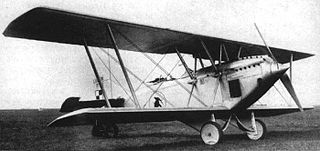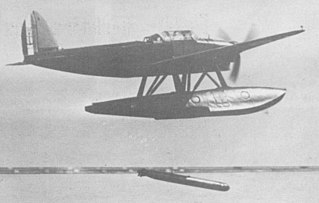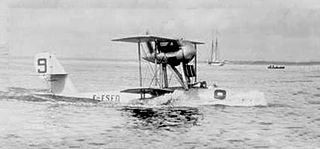Operators
 France
France
| Bo.T | |
|---|---|
| Role | Torpedo-reconnaissance floatplane |
| National origin | France |
| Manufacturer | Antoine Odier |
| Design group | Etablissements Borel |
| First flight | 1916 |
| Primary user | French Navy |
| Number built | 92 |
The Borel-Odier Bo-T (also known as the Borel-Odier torpedo floatplane or B.O.2) was a French twin-engined float biplane designed by Borel but built by Antoine Odier for the French Navy. [1]
The Bo-T was a biplane powered by two 164 kW (220 hp) Hispano-Suiza 8Ba inline piston engines and fitted with twin floats. [1] It had room under the fuselage for a torpedo. [1] The prototype was destroyed on the first flight in August 1916 but the French Navy still placed and order for 91 aircraft. [1] Deliveries did not start until 1917 and were stopped when the Armistice was signed. [1] Only a few aircraft saw operational use on coastal patrols in the mediterranean. [1]
In 1919 a ten-passenger transport variant was flown designated Bo-C/Bo.20 but it was destroyed during testing. [1]
Data from The Illustrated Encyclopedia of Aircraft, [1] French aircraft of the First World War [3]
General characteristics
Performance
Armament
Related lists

The Lublin R-VIII was a Polish bomber, reconnaissance aircraft and seaplane designed in the late 1920s by the Plage i Laśkiewicz factory in Lublin. It was the first in-house design of Plage i Laśkiewicz, and the first with the name Lublin.

The Latécoère 298 was a French seaplane that served during World War II. It was designed primarily as a torpedo bomber, but served also as a dive bomber against land and naval targets, and as a maritime reconnaissance aircraft. Of a sturdy and reliable construction and possessing good manoeuvrability, it was France's most successful military seaplane, and served throughout the war in various guises.

The Douglas T2D was an American twin-engined torpedo bomber contracted by the military, and required to be usable on wheels or floats, and operating from aircraft carriers. It was the first twin-engined aircraft to be operated from an aircraft carrier.

The Fiat CR.1 was an Italian biplane fighter aircraft of the 1920s. Of wood-and-fabric construction, it was designed by Celestino Rosatelli, from whom it gained the 'CR' designation. Its most distinctive feature was that the lower wings were longer than the upper ones.

The Breda A.4 was a biplane trainer produced in Italy in the mid-1920s. It was of conventional configuration with a two-bay unstaggered wing cellule and seating for the pilot and instructor in tandem open cockpits. Apart from civil use, the A.4 was also adopted by the Regia Aeronautica as a trainer. At least some examples were produced in floatplane configuration as the A.4idro.

The Gourdou-Leseurre GL-832 HY was a 1930s French light shipboard reconnaissance floatplane designed and built by Gourdou-Leseurre for the French Navy.

The Vickers Vendace was a 1920s British trainer aircraft. It was originally designed as a floatplane trainer for the Royal Air Force.

The Supermarine Sea King was a British single-seat amphibious biplane fighter designed by Supermarine in 1919. Developed from the Supermarine Baby and the Supermarine Sea Lion I, the Sea King was a single seater biplane powered by a pusher 160 horsepower (120 kW) Beardmore engine. It first flew in early 1920 and was exhibited by Supermarine at the 1920 Olympia Show in London. The company released drawings of the aircraft's design prior to the show; what it exhibited was probably a modified Supermarine Baby.

The FBA Type H was a French reconnaissance flying boat produced in large numbers in France and Italy during World War I by Franco-British Aviation.
The Handley Page HP.14, also designated Handley Page R/200 was a prototype British naval reconnaissance aircraft of World War I, capable of operating from the decks of the Royal Navy's aircraft carriers or as a floatplane. Only three were built, the Parnall Panther being preferred.

The Lioré et Olivier LéO H-13 was a French biplane two-engine flying boat of the 1920s, built in passenger and military variants.

The Potez 39 was a French two-seat single-engined parasol wing monoplane reconnaissance and observation aircraft of the 1930s.

The CAMS 31 was a 1920s French single-seat fighter biplane flying-boat designed and built by Chantiers Aéro-Maritimes de la Seine (CAMS).

The Potez X was a French 1920s general-purpose colonial transport aircraft designed and built by Potez.
The Bellanger-Denhaut 22 was a twin-engined bomber/reconnaissance flying boat designed by François Denhaut the technical director for seaplanes for the car manufacturer Bellanger.

The CAMS 38 was a French single-seat racing flying-boat designed by Raffaele Conflenti and built by Chantiers Aéro-Maritimes de la Seine (CAMS) for the 1923 Schneider Trophy race. The CAMS 38 was withdrawn from the race during the second lap.
The Adolphe Bernard AB was a twin-engined French biplane aircraft, built near the end of the First World War. Ten AB 1 BN2 bombers were produced for the Armée de l'Air but did not reach squadron service; post-war, two civil derivatives were considered but only one aircraft was built.

The CAMS 36 was a 1920s French flying boat designed and built by Chantiers Aéro-Maritimes de la Seine. It was originally conceived as a single-seat fighter but evolved as a racer to compete in the 1922 Schneider Trophy race. Lack of funds in 1922 and an accident in 1923 meant the two aircraft built failed to participate in a Schneider race.
The Tellier T.2 was a French two-seat patrol biplane flying-boat built by Société Alphonse Tellier et Cie à Neuilly (hull) and Voisin (wings). The wooden-hull flying boat used a 150 kW (200 hp) Hispano-Suiza 8Ba engine and was first flown in June 1916.
The Gourdou-Leseurre GL-820 HY family of four-seat single-engined floatplanes were designed and built in France during the latter half of the 1930s by Gourdou-Leseurre. The GL-820 HY and GL-821 HY 02 were shipborne reconnaissance / observation aircraft, while the sole GL-821 HY was built as a torpedo carrier.